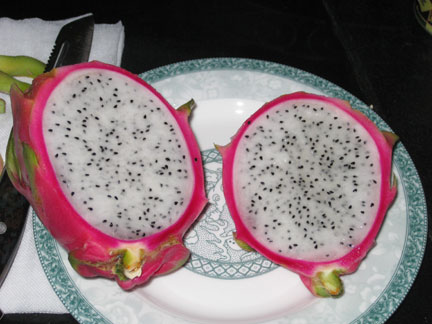 There are many strange and exotic things for sale at the local fruit stands. One such item was this strange thing (pictured on the right). We saw it in a number of fruit stores yet we never bought it because…well, we had no idea what it was.
There are many strange and exotic things for sale at the local fruit stands. One such item was this strange thing (pictured on the right). We saw it in a number of fruit stores yet we never bought it because…well, we had no idea what it was.
The other day in class one of my students had one on her desk. The best thing about teaching 240 kids a week is you have a lot of people who are willing to explain things to you. So I picked it up and asked the class,
“What the heck is this?”
They all laughed and then took out their pocket translators and told me it was called ‘Dragon Fruit.’
“How do you eat it?”
“Does it taste good?”
“Why is it called Dragon fruit?”
I had a million questions and they were able to answer some of them for me, (for instance they said it tasted “good” and you eat it like a melon) and after a few minutes of discussing it we went back to the lesson. During the break one of my students came up with a bunch of information. She said it was high in iron, good for the blood, was a weight loss fruit and made your skin whiter (a much sought after trait in China). She said there was a story related to dragons, but she didn’t know it.
At the end of class the student gave me the fruit and said, “for you to try.” To be honest, I felt a little bit guilty. I asked the class just because I was honestly curious but I’m not sure if I accidentally stumbled upon some cultural hierarchy gift giving thing. (Like, if your teacher shows interest in something you are suppose to give it to them as a gift.) Basically, I felt as if I stole her snack.
But I put it to good use, washed it and a few days later I cut it open. (Culture tip: Always wash the outside of the fruit even if you don’t eat it. The outside can have bacteria that you transfer to the inside from the knife cutting through it.) Imagine my surprise when I saw the inside:

Turns out it has a white fleshy fruit on the inside with teeny, tiny black seeds. Some people eat it with a spoon, while I cut it into strips and ate it like a melon. The flesh was quite juicy and tasted a lot like a kiwi, albeit a little less flavorful.It doesn’t have that ‘citrus-y’ tang that kiwi fruit has but it has a nice juicy consistency.
It turns out the dragon fruit is not unique to China or Asia. In fact, it is popular in South America and Mexico as well, and grows only in tropical areas. (Other names for it is Pataya or Pitahaya.) It favors tropical climates because it isn’t a typical fruit that grows on a bush or a tree. It is actually the fruit of a cactus!
(Here is a picture of it growing I found on Wikipedia:)

It turns out it is a very nutritious fruit that is high in Vitamin C and is good for lowering high blood pressure and high cholesterol. It is also helps control glucose levels if you are diabetic. The dried form of this fruit contains a higher concentration of vitamins and is actually better for you. (But in my experience the dried stuff doesn’t taste nearly as good.)
This fruit should be available in September and October at some supermarkets in America, so keep you eyes out for them and give it a shot yourself and let me know what you think of it!
Hit enter to search or esc to close


Dear friend,
I live in China (Beijing) and, for the first time of my life, I got the Dragon fruit in Vietnam.
I liked it more for it shapes and colours than for its flavor.
I use it for making fruit salad and decoration.
Today, in Beijing, is cold but the sky is very blue.
The contrast between the sky and the white snow(last sunday we had a lot of snow)is really magic.
Have a nice day!
Thanks Gisa,
I do think the dragon fruit is perfect for decoration and I’ve started noticing it more, now that I know what it looks like, on top of cakes and such.
HI Becky,
It’s growing in our yard here in Hawaii!
San (Renee and Barry’s friend)